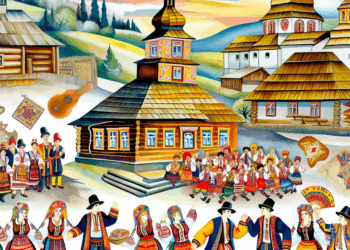Introduction
Bukovyna is a region located in north-western Ukraine and south-eastern Romania. Its history is full of changes and annexations from the eighteenth century to its modern limits. In the twentieth century, the territorial changes of the region were significant and determined by many factors, including war, national politics and international agreements.
1. the Austrian Empire (1775)
In 1775, Bukovina was annexed by the Austrian Empire, marking a new era for the region. Until then, Bukovina had been under the Ottoman Empire, but changing political power in Central and Eastern Europe led to its incorporation into the Austrian lands. From the moment of annexation, the Austrian administration began the process of integrating Bukovina into the imperial structure, which led to significant cultural and economic transformation.
The Austro-Turkish War (1787-1791) also contributed to the consolidation of the Christian population in the region, resulting in an increase in the number of schools and cultural institutions. This time was the first attempt to unite the multi-layered population of the region, where different ethnic groups – Ukrainians, Romanians, Jews and Germans – lived.
2. The period after the First World War (1918)
With the end of World War I and the dissolution of Austria-Hungary in 1918, Bukovina became the subject of disputes between the new Romania and the Ukrainian People’s Republic. As a result of geopolitical intricacies and border changes, regions including Chernivtsi, the administrative centre of Bukovina, were declared part of Romania.
Under Romanian rule, Bukovina experienced a cultural renaissance, despite the difficulties associated with the integration of various ethnic groups. The Romanian government’s policies towards national minorities sometimes caused tensions, especially among Ukrainians and Jews. It was a time of active cultural and educational activities.
Nevertheless, despite all efforts, Bukovinians remained torn between two identities – Romanian and Ukrainian. The period of Romanian integration was greatly hampered by internal conflicts and economic problems.
3. Soviet annexation (1940)
In 1940, under a secret addendum to the Molotov-Ribbentrop Pact, the Soviet Union annexed part of Bukovina, recognising it as part of the Ukrainian Radiance Socialist Republic. This process was also part of a broader geopolitical change in Eastern Europe.
The Soviet regime initiated intensive industrialisation and collectivisation. This led to significant changes in the social structure of the region. As a result of repression and deportations, many national minorities, including a significant number of Jews, were forced to leave their homes, which dramatically changed the demographic composition of the region.
Although the Soviet regime was based on ideas of internationalism, in practice a policy of Ukrainianisation was implemented, which was sometimes met with resistance from the local population, especially the Romanian population. This period was also characterised by a change in the way of life, which affected the everyday life and habits of the Bukovinians.
4. After the Second World War and the establishment of modern borders
After the end of the Second World War, the situation in Bukovyna changed again. As a result of decisions at the Potsdam Conference in 1945, Western Bukovina remained part of the Soviet Union, while Southern Bukovina remained part of Romania. These decisions fixed the modern borders: most of Bukovina became part of Ukraine.
As a result of the change in the political map of the region, which continued throughout the 20th century, many residents experienced difficulties related to the loss of cultural identity and social adaptation. However, with the independence of Ukraine in 1991, the population of Bukovina began to redefine their identity once again. At this stage, Romanian and Ukrainian cultures began to coexist more harmoniously, which allowed for the development of intercultural ties.
5. Contemporary realities
The current border of Bukovyna, which separates Ukraine and Romania, is of interest and often a subject of debate. The region has become an important part of Ukrainian identity, but the cultural connection with Romania continues to be a serious aspect of cultural life, especially among the Romanian population.
In recent years, there has been a renewed interest in intercultural dialogue. Cultural projects based on joint Romanian and Ukrainian initiatives are increasingly becoming part of public life. This leads to stronger ties between the two states and increased mutual understanding.
Conclusion
The history of Bukovina in the 20th century is a complex ensemble of events, annexations and cultural transformations. This region, often an artefact of conflicts and changes, has not lost its versatility and diversity. Despite all the political and social difficulties, the people of Bukovina continue to form a unique identity that is cross between Romania and Ukraine.
These historical vicissitudes shape the unique identity of Bukovina, highlighting the importance of cultural heritage and the need for cultural dialogue between different ethnic groups. Bukovyna remains a symbol of historical complexity and cultural multilayering, making it an important object of study for historians and social scientists.








